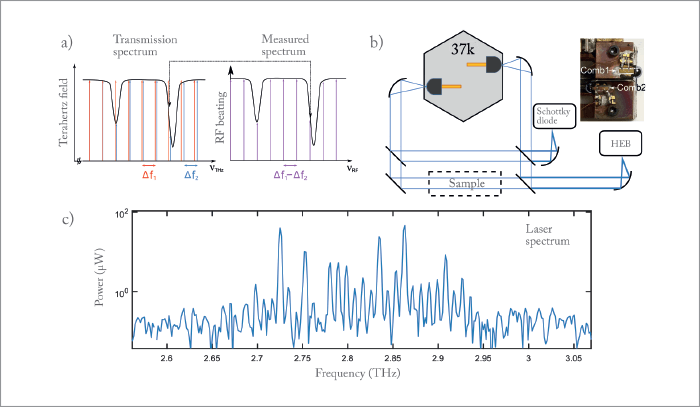A research team from MIT have developed a form of terahertz spectroscopy that could be key to non-invasive security screening. The group has been working in the terahertz region for more than 20 years, and after demonstrating THz quantum cascade laser (QCL) frequency combs in 2014 (1), the main research goal became to improve the laser frequency comb performance. “The main focus of our research is to develop better THz QCLs as well as related applications,” says Yang Yang, graduate researcher. “The fascinating frequency comb-based spectroscopy results coming from the mode-lock laser community made us want to try comb-based spectroscopy using our own lasers. As soon as we got decent lasers, exploring laser based spectroscopy systems became the natural choice!”


Yang says that terahertz is a unique field of great importance for spectroscopy, as it is a range where lots of molecules have fingerprints. “By conducting broadband spectroscopy at terahertz, one can not only elucidate those molecules but also identify their concentrations,” he says. “Frequency combs based on terahertz QCLs feature broadband coverage and high output powers in a compact package, making them an attractive option for broadband spectroscopy.” According to Yang, multiheterodyne spectroscopy based on two frequency combs (2,3) – also known as dual-comb spectroscopy – offers an “elegant” way of conducting broadband spectroscopy, as it features broad spectral coverage, high frequency resolution, and high signal-to-noise ratios obtained over short acquisition times – all without mechanical moving parts. “The significance is that it demonstrates the feasibility of THz QCL combs for spectroscopy applications given their chip-size volume – THz QCLs are the only chip-size coherent light source at THz. Their performance is compatible to traditional coherent THz sources, such as gas lasers, which are much larger,” says Yang. “We have spent a long time developing an algorithm to retrieve data given strong environment feedback, and we can use that same algorithm to analyze data when our combs are under pulsed-mode biasing – something we previously believed to be impossible. That was quite surprising.” With its potential for detecting explosives and noxious gases (as well as screening mail and personnel), the new technique could play an important role in homeland security. “Explosive materials absorb THz light strongly at certain terahertz frequencies but not at others, and this ‘terahertz fingerprint’ can be used to identify an explosive, distinguishing it from clothing or other inert materials,” Yang says. “Because clothing is transparent at terahertz frequencies, the THz light can pass through several layers, including common garments and shoes, providing a less invasive screening method.” Manufacturer TeraView claims the technology is capable of detecting different types of plastic explosives, including PETN (pentaerythritol tetranitrate) – a material used in several terrorist bombings but notoriously difficult to detect.
References
- Y Yang et al., “Terahertz multiheterodyne spectroscopy using laser frequency combs”, Optica, 3, 499-502 (2016). S Schiller, “Spectrometry with frequency combs”, Optics Letters, 27, 766-158 (2002). F Keilmann et al, “Time-domain mid-infrared frequency-comb spectrometer”, Optics Letters, 29, 1542-1544 (2004).




